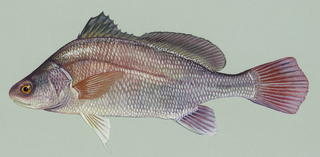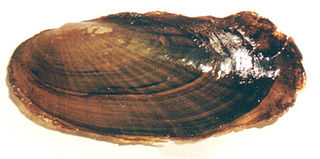
The hammerhead sharks are a group of sharks that form the family Sphyrnidae, named for the unusual and distinctive form of their heads, which are flattened and laterally extended into a cephalofoil. The shark's eyes are placed one on each end of this T-shaped structure, with their small mouths directly centered and underneath. Most hammerhead species are placed in the genus Sphyrna, while the winghead shark is placed in its own genus, Eusphyra. Many different—but not necessarily mutually exclusive—functions have been postulated for the cephalofoil, including sensory reception, manoeuvering, and prey manipulation. The cephalofoil gives the shark superior binocular vision and depth perception.

Mackerel is a common name applied to a number of different species of pelagic fish, mostly from the family Scombridae. They are found in both temperate and tropical seas, mostly living along the coast or offshore in the oceanic environment.

Herring are forage fish, mostly belonging to the family of Clupeidae.

The term carp is a generic common name for numerous species of freshwater fish from the family Cyprinidae, a very large clade of ray-finned fish mostly native to Eurasia. While carp are prized quarries and are valued as both food and ornamental fish in many parts of the Old World, they are considered trash fish and invasive pests in many parts of Africa, Australia and most of the United States.

The yak, also known as the Tartary ox, grunting ox, hairy cattle, or domestic yak, is a species of long-haired domesticated cattle found throughout the Himalayan region of Gilgit-Baltistan, Nepal, Sikkim (India), the Tibetan Plateau (China), Tajikistan and as far north as Mongolia and Siberia. It is descended from the wild yak.

Sardine and pilchard are common names for various species of small, oily forage fish in the herring suborder Clupeoidei. The term 'sardine' was first used in English during the early 15th century; a somewhat dubious etymology says it comes from the Italian island of Sardinia, around which sardines were once supposedly abundant.

The flathead catfish, also called by several common names including mudcat or shovelhead cat, is a large species of North American freshwater catfish in the family Ictaluridae. It is the only species of the genus Pylodictis. Ranging from the lower Great Lakes region to northern Mexico, it has been widely introduced and is an invasive species in some areas. The closest living relative of the flathead catfish is the much smaller widemouth blindcat, Satan eurystomus, a cavefish.

Wobbegong is the common name given to the 12 species of carpet sharks in the family Orectolobidae. They are found in shallow temperate and tropical waters of the western Pacific Ocean and eastern Indian Ocean, chiefly around Australia and Indonesia, although one species occurs as far north as Japan. The word wobbegong is believed to come from an Australian Aboriginal language, meaning "shaggy beard", referring to the growths around the mouth of the shark of the western Pacific.

The sauger is a freshwater perciform fish of the family Percidae that resembles its close relative, the walleye. The species is a member of the largest vertebrate order, the Perciformes. It is the most migratory percid species in North America. Saugers have two dorsal fins; the first is spiny and the posterior dorsal fin is soft-rayed. Their paired fins are in the thoracic position and their caudal fin is truncated, which means squared off at the corners, a characteristic of the family Percidae. Another physical characteristic of saugers is their ctenoid scales, which are common in advanced fishes. Saugers have a fusiform body structure, and as a result are well adapted predatory fishes and are capable of swimming into fast currents with minimal drag on their bodies. They may be distinguished from walleyes by the distinctly spotted dorsal fin, by the lack of a white splotch on the caudal fin, by the rough skin over their gills, and by their generally more brassy color, or darker color in some regions. The typical sauger is 300 to 400 g in weight.

The freshwater drum, Aplodinotus grunniens, is a fish endemic to North and Central America. It is the only species in the genus Aplodinotus, and is a member of the family Sciaenidae. It is the only North American member of the group that inhabits freshwater for its entire life. Its generic name, Aplodinotus, comes from Greek meaning "single back", and the specific epithet, grunniens, comes from a Latin word meaning "grunting". It is given to it because of the grunting noise that mature males make. This noise comes from a special set of muscles within the body cavity that vibrate against the swim bladder. The purpose of the grunting is unknown, but due to it being present in only mature males and during the spawning season, it is assumed to be linked to spawning.

The smallfin gulper shark or endeavour dogfish, is a medium-sized deepwater dogfish in the family Centrophoridae.
Limnonectes grunniens is a species of frog in the family Dicroglossidae. It is found in Sulawesi, Molucca Islands, and New Guinea. Frogs from Sulawesi may represent a different, undescribed species.

Ellipsaria lineolata is a species of freshwater mussel, an aquatic bivalve mollusk in the family Unionidae, the river mussels. This is the sole species in the monotypic genus Ellipsaria . This species is native to the drainage systems of the Mississippi River, the Mobile River, the Tennessee River, and the Cumberland River in the United States. It exists in the midwestern United States, and has also been observed in the east coast and as far south as the Gulf of Mexico. The common name of Ellipsaria lineolata is the Butterfly Mussel.

Potamilus leptodon, the scaleshell mussel or scale shell, is a species of freshwater mussel in the family Unionidae, the river mussels. This aquatic bivalve mollusk has disappeared from much of its historical range. It is endemic to the United States, where it is now present in four or fewer states; it is only found with any regularity in Missouri. It is a federally listed endangered species of the United States.
Potamilus amphichaenus, the Texas heelsplitter, is a species of freshwater mussel, an aquatic bivalve mollusk in the family Unionidae, the river mussels. Freshwater Drum were confirmed as the host fish species for the glochidia reproductive stage of the Texas Heelsplitter.

An anchovy is a small, common forage fish of the family Engraulidae. Most species are found in marine waters, but several will enter brackish water, and some in South America are restricted to fresh water.

Allenbatrachus is a genus of toadfishes found in the Indian and western Pacific Oceans. The generic name honours the Humboldt State University ichthyologist George Allen (1923-2011), who introduced David Greenfield, who coined the name, to ichthyology.

The wild yak is a large, wild bovine native to the Himalayas. It is the ancestor of the domestic yak.

















